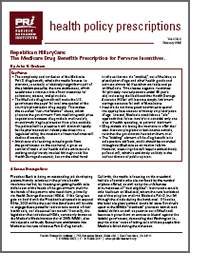The looming insolvency of Medicare is disappointingly absent from the list of policy issues on the carte du jour for the November general election. Fortunately, the current Administration recognizes the clear and present danger of Medicare insolvency. “Time is running out. Medicare is drifting toward disaster,”1 said U.S. Secretary of Health and Human Services Michael O. Leavitt earlier this month.
Two months ago, I addressed the looming fiscal crisis in Medicare, and questioned why the President had not really succeeded in injecting a healthy dose of consumer-direction into the program, as he has in private health insurance and (to some degree) Medicaid. Indeed, Medicare, the single-payer program for seniors, has been a black hole for consumer-driven reform. It is illegal for Medicare beneficiaries to fund Health Savings Accounts (HSAs), although they can maintain and spend from accounts that they opened prior to enrolling in Medicare. It took until January 2007 for the government finally to allow consumer-driven Medicare Medical Savings Account (MSA) plans – three years after HSAs started in the private market. MSA plans look very similar to the high-deductible health plans that qualify working-age Americans to open HSAs. Unfortunately, slightly more than 3,000 of 44 million Medicare beneficiaries were in Medicare MSA plans in February 2008 – not even a rounding error.2
Unfortunately, Congress is blocking the Administration’s intention of saving money and improving quality in Medicare in many ways – and even threatening to roll back some of the innovations launched by the Medicare Modernization Act of 2003 (MMA), which have yet to take hold. For example, the MMA took a significant step away from government price-fixing for durable medical equipment, such as oxygen tanks or mail-order diabetic supplies for Medicare beneficiaries, by mandating competitive bidding for a number of those items.

